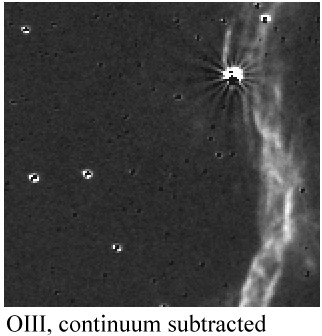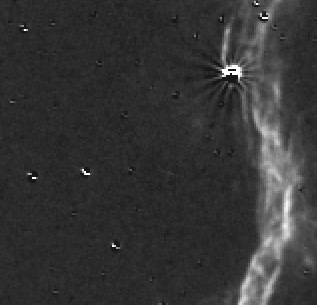
above: the power of continuum subtraction is unrivalled for revealing faint nebulosity


At first glance everything looks fine: nebulosity + stellar continuum on one image; only stellar continuum on the other. However, the stellar point spread function (PSF) has a FWHM of ~2.0 pixels on the narrowband image and ~1.5 pixels on the continuum image. When subtracting the stellar continuum under such conditions bright or dark halo artifacts will then arise at each star position:

To investigate further I used AIP4WIN (extractive photometry) to map the stellar FWHM across the entire field of view of each image:

The stellar FWHM varies from roughly 1.5-3 pixels and it does so differently on each image. Differences in FWHM can arise due changes in seeing, focussing and lens mounting and are in my experience very hard to eliminate completely with fast lenses.
My strategy has been for each pixel to determine which image has the smallest FWHM and then blur it so that it matches the FWHM of the other image. I made a program for doing this in Mathematica; the FWHM distributions after this selective blurring are shown below:

The FWHM distributions are now very similar and the continuum subtraction will result in fewer halo artifacts:

The subtraction is still not perfect, which is mainly due to the fact that I have assumed circular PSF's. In reality the PSF is often slightly elongated and of course this, too, varies in magnitude and direction across both fields of view. With more advanced software this effect could be mapped automatically and an appropriate elongated blur be applied where needed. For now, though, I have not taken this effect into account. Saturated stars also lead to artifacts after continuum subtraction, as is also evident above.

Hence, the stellar signal can be continuously varied without affecting the nebulosity signal. If the reduction is pushed too far many artifacts will arise. I find that a stellar reduction up to ~70-85% can be acheived without getting too many artifacts.
Finally, to repair the artifacts that do arise I use a scaled version of the continuum image to replace pixels that have become negative:

For color imaging the procedures outlined above can be applied seperately to each channel. An example is shown at the top of
this page. I am very interested in hearing details about how others have dealt with the challenges of continuum subtraction, so
do not hestitate to mail me your comments.
Here's my main page where you can see more of the pictures I have taken so far.
Comments greatly appreciated! (mikael@leif.org)